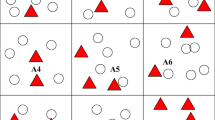Abstract
Recently the deployment of IEEE 802.11 Wireless Mesh Networks (WMNs) has been growing exponentially attributing to sharing economy of WiFi. As a result, the handoff delay caused by mobile client (MC) probing for the next preferred AP imposes more challenges for time-sensitive mobile applications such as VoIP, video chat, and IoT in a dense WMN with more and more MCs and APs. In this work, we exploit the characteristic of dense network and propose two fast handoff schemes, namely T-NRS (Temporal-Network Radio Signature) and OppoScan. T-NRS scheme leverages historical knowledge of associated APs in time series together with radio signature technique based on spatial knowledge to assist in fast handoff, while OppoScan scheme opportunistically leverages nearby MCs and APs to produce the required information of neighboring AP for handoff and thus significantly decrease the number of switching channel of APs. We implement and evaluate the mechanisms in testbed of about 200 APs in shopping malls. The results prove that the performance of the proposed schemes is satisfactory while cost less than previous approaches.



















Similar content being viewed by others
Explore related subjects
Discover the latest articles and news from researchers in related subjects, suggested using machine learning.References
Mhatre V, Papagiannaki K (2006) Using smart triggers for improved user performance in 802.11 wireless networks. In: proceedings of the 4th international conference on mobile systems, applications and services, January 2006, pp. 246–259
Mishra A, Shin M, Arbaugh W (2003) An empirical analysis of the IEEE 802.11 MAC layer handoff process. ACM SIGCOMM Comp Commun Rev 33(2):93–102
Mishra A, Shin M, Arbaugh W (2004) Context caching using neighbor graphs for fast handoffs in a wireless network. In: proceedings of INFOCOM 2004, March 7–11 2004
Velayos H, Karlsson G (2004) Techniques to reduce IEEE 802.11b MAC layer handover time. In: proceeding of IEEE ICC 2004, June
Ramani I, Savage S (2005) SyncScan: practical fast handoff for 802.11 infrastructure networks. In: INFOCOM
Liao Y, Gao L (2006) Practical schemes for smooth MAC layer handoff in 802.11 wireless networks. In: WoWMoM
Haitao Wu, Tan K, Zhang Y, Zhang Q (2007) Proactive scan: fast handoffwith smart triggers for 802.11 wireless LAN. In: INFOCOM
Teng J, Xu C, Jia W, Xuan D (2009) D-scan: enabling fast and smooth handoffs in AP-dense 802.11 wireless networks. In: INFOCOM
Yao G, Cao J, Yan Y, Ji Y (2010) Secured fast handoff in 802.11-based wireless mesh networks for pervasive internet access. IEICE Trans Inf Syst. E93–D(3):411–420
Berezin ME, Rousseau F, Duda A (2011) Multichannel virtual access points for seamless handoffs in IEEE 802.11 wireless networks. In: proceedings of IEEE 73rd vehicular technology conference (VTC Spring), May 2011
Brik V, Mishra A, Banerjee S (2005) Eliminating handoff latencies in 802.11 WLANs using multiple radios: applications, experience, and evaluation. In proceeding of ACM SIGCOMM, August 2005
Jin S, Choi S (2014) A seamless handoff with multiple radios in IEEE 802.11 WLANs. IEEE Trans Veh Technol 63(3):1408–1418
Berezin ME, Rousseau F, Duda A (2011) Multichannel virtual access points for seamless handoffs in IEEE 802.11 wireless networks. In: proceeding IEEE 73rd vehicular technology conference (VTC Spring), May 2011, pp 1–5
Singh G, Atwal A, Sohi B (2006) A signalling technique for disseminating neighbouring AP channel information to mobile stations. In: ICDCN 2006, Springer, Berlin
Singh G, Atwal A, Sohi B (2008) Effect of background scan on performance of neighboring channels in 802. 11 networks. Int J Commun Netw Distrib Syst 1(1):19–32. https://doi.org/10.1504/IJCNDS.2008.017202
Jun J, Gu Y, Cheng L, et al (2013) Social-Loc: improving indoor localization with social sensing, SenSys 2013
Chen H, Chen Y L, Wu C H, et al (2017) EcoLoc: toward universal location sensing by encounter-based collaborative indoor localization. In: proceedings of the second international conference on internet-of-things design and implementation. ACM, 2017:215–220
Vanderhulst G, Mashhadi A, Dashti M, et al (2015) Detecting human encounters from wifi radio signals. In: proceedings of the 14th international conference on mobile and ubiquitous multimedia. ACM, 2015:97–108
Yao G, Cao JN, Liu XF et al (2017) OppoScan: enabling fast handoff in dense 802.11 WMNs via opportunistic probing with virtual radio. In: IEEE 14th mobile ad hoc and sensor systems (MASS), pp 198–205, October 2017
Yao G, Cao JN, Liu XF et al. (2018) Fast Handoff based on Enhancement of Network-assisted Radio Signature in 802.11 Dense WMNs, Accepted by ACM International Conference on Distributed Computing and Networking (ICDCN), January 20
Acknowledgements
This work is supported by the NSFC Key Grant with Project No.61332004 and Hong Kong RGC General Research Fund under Grant PolyU152199/17E
Author information
Authors and Affiliations
Corresponding author
Rights and permissions
About this article
Cite this article
Yao, G., Cao, Jn., Liu, X. et al. Enabling fast handoff in dense 802.11 WMNs via temporal-spatial knowledge and opportunistic probing. J Reliable Intell Environ 4, 57–70 (2018). https://doi.org/10.1007/s40860-018-0057-2
Received:
Accepted:
Published:
Issue Date:
DOI: https://doi.org/10.1007/s40860-018-0057-2




